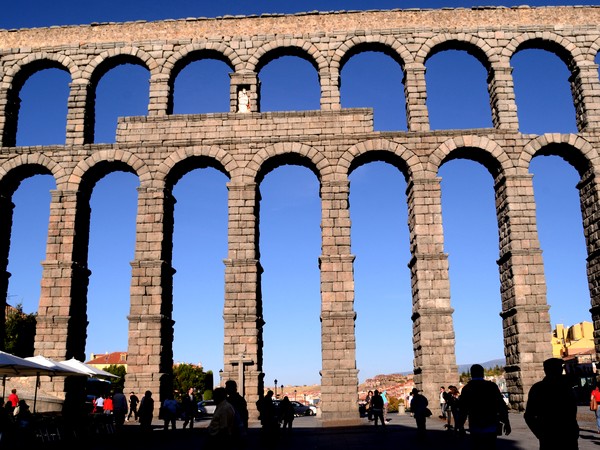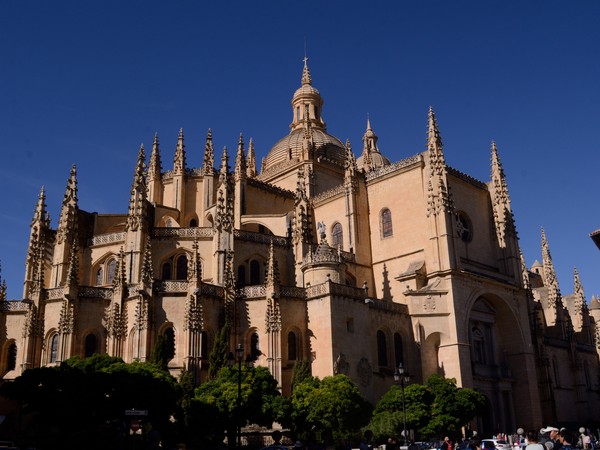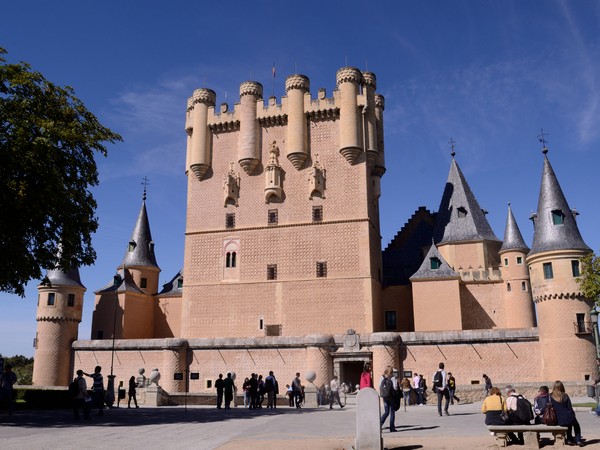Photographs: Lakshmi Sharath Lakshmi Sharath
Lakshmi Sharath is a media professional and traveller who recently visited Segovia in Spain. Here is her travelogue:
There is a huge crowd that has gathered right in the middle of the square in Segovia in Spain, cheering to the music while some dancers are setting the rhythm for the evening. They seem to be in the midst of a local festival. The energy is in the air as the entire town lands up in this little square, greeting each other and joining in the pageantry.
However, I turn my gaze away from the crowds and look at the massive aqueduct that cuts across the length of the town, basking in the evening sunlight. Standing tall and silent, it is the showstopper of Segovia, looking larger than life and reminding people of the days the Romans built it way back -- sometime between the 1st and 2nd centuries.
We find a place to stand near the aqueduct as the festivities gather momentum here. The presiding deity of Segovia, Our Lady of the Fuencisla is getting ready for a procession and is heading back to her monastery after her brief stay at the Cathedral in Segovia. We are unable to find a vantage point but a couple of older women show us the way as we get a glimpse of the spectacle.
Click here to upload your travel pictures on Rediff ZaraBol! Post a description of your photo (eg where it was taken, when etc) in less than 140 characters and we will publish your pictures right here on Rediff.com and India Abroad.Lakshmi Sharath is a travel writer and blogger from Bangalore and she blogs at http://backpakker.blogspot.com.
STUNNING PHOTOS: The historic city of Segovia
Image: Legends attribute the aqueduct bridge of Segovia to a devil's handiworkPhotographs: Lakshmi Sharath
The evening light is beautiful as the entire aqueduct, often referred to as the aqueduct bridge glows, the rays of light shining through the 166 arches. A symbol of Segovia as seen by its presence on the city's coat of arms, the Romans had originally built it to bring water from the mountains to the town. But legends of course attribute it to a devil's handiwork.
A beautiful maiden struck a deal with the devil who promised her water to her doorstep as she was tired of carrying water across the city. She had to part with her soul if the devil kept his side of the bargain before the rooster crowed. The girl prayed to the Lord after realising her mistake who answered her prayers by sending out a storm and delaying the process. As dawn broke, the devil had failed by just a single stone block. The Segovians however forgave the girl and sprinkled holy water on the arches and accepted the aqueduct.
In reality however the long aqueduct bridge runs for 15 km until it reaches the city and it was built with huge granite blocks from the Guadarrama Mountains, located another 17 km away, without any concrete or mortar between the stones. There are two vaulted niches from the ancient times with an inscription that refers to the foundation of the aqueduct.
STUNNING PHOTOS: The historic city of Segovia
Image: Segovia CathedralPhotographs: Lakshmi Sharath
We walk around and see the setting sun glow as the lights of the cathedral come up. It is the last Gothic cathedral to be built in Spain, way back in the 16th century. It glows even brighter as twilight comes up and I walk aimlessly and stare at it endlessly. It is my first day in Segovia and I have already struck a bond with the city.
Morning dawns and I watch the first rays of the sun caress the mountains, lighting up the entire monument-scape. The entire city sits on a craggy limestone rock and it seems to be ringed in - first by the mountains and then by the city walls guarding an old town inside their fold. I can see the mountains slowly unveiling themselves in the dawn, as the monuments stand out to announce their presence. The aqueduct is there, right in the centre as a cluster of steeples and church towers surround it.
STUNNING PHOTOS: The historic city of Segovia
Image: The Alcazar of SegoviaPhotographs: Lakshmi Sharath
My eyes now look upon the Alcazar or the Fortress that stands apart from the crowd of monuments. The tourist brochure compares it to a ship made of stone, with the two rivers - Eresma and Clamores surrounding it as it stands tall amidst the multi hued landscape . A montage of green, blue, ochre and brown colours fill your eyes as the palace rises above all other monuments, basking in the morning light.
Our drive to the Alcazar gives us a better understanding of the history of the city that has seen several influences. A town of Celtiberian origin, it was part of the Roman Empire but was abandoned during the Islamic invasion, only to be repopulated again in the 11th century by Christians. As you wander through the walls of the city, you realise it was once a prosperous town with a robust textile industry and the old Jewish quarter gives testimony to the same.
Soon the landscape opens out into the mountains, one of them in silhouette referred to as 'Mujer Muerta' or the Dead Woman. There are many stories, but one of them stays in my mind. It speaks of a sacrifice of a mother who gave up her life to stop her warring sons. The story goes that while the sons were getting ready for a bitter battle, the mother prayed to God to take her life instead.
A snow storm suddenly interrupted their fight and they suddenly saw a mountain arise out of the plains, covered with snow. Locals say that the sons go there every evening to kiss their mother, whenever they see the clouds gather around the summit.
However we are close to the Alcazar, the fortress and the palace which was probably of Arab origin, built on the remains of a Roman fort. None of the old structure however remains today. What we see in front of us is a towering structure from the Middle Ages that was once the home of the emperors of Castiles, including their favourite queen, Isabel 1. The palace is now a veritable art gallery that takes you on a pictorial journey of its own history, along with that of the town.
STUNNING PHOTOS: The historic city of Segovia
Photographs: Lakshmi Sharath
The day almost ends as we come back to the town. I sit in a bench on the square and watch life pass by at Segovia. A century old confectionery shop beckons me and I meet a lady who has been making "el ponche segoviano" a traditional Segovian delicacy for years.
As I munch on a piece of the Segovian punch -- a delicious cake made of egg, flour, marzipan, topped with cream and sugar , soaked in alcoholic spirit, I look around and see the walls which is filled with pictures of old Segovia and how the town has changed over the years. The sun goes down again and I return to my room, having had a taste of Segovia.
Click here to upload your travel pictures on Rediff ZaraBol! Post a description of your photo (eg where it was taken, when etc) in less than 140 characters and we will publish your pictures right here on Rediff.com and India Abroad.Lakshmi Sharath is a travel writer and blogger from Bangalore and she blogs at http://backpakker.blogspot.com.






Comment
article